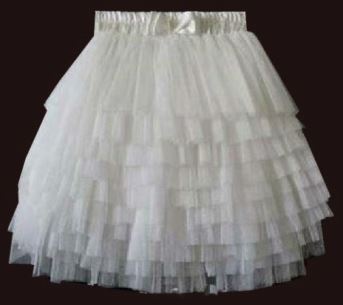Tulle is a soft, fine silk, cotton, or nylon material like net, used for making veils and dresses.
One of the most common uses for tulle netting is in garments. Tulle is often used as an accent, to create a lacy, floating look. Tulle may also be used in underskirts or petticoats to create a stiff belled shape. Gowns are often puffed out with the use of several layers of stiff tulle.
 A tulle skirt is often worn when a female
wants to wear a more fluffed out and shapely skirt. Tulle is fabric
that is used to make bridal veils, scarves, gowns, tutus, skirts and
various other pieces of clothing. When making a skirt or tulle dress,
it can often be better to sew it by hand, as the fabric can get caught
up in the sewing machine and tear or cause other problems.
A tulle skirt is often worn when a female
wants to wear a more fluffed out and shapely skirt. Tulle is fabric
that is used to make bridal veils, scarves, gowns, tutus, skirts and
various other pieces of clothing. When making a skirt or tulle dress,
it can often be better to sew it by hand, as the fabric can get caught
up in the sewing machine and tear or cause other problems.
The name comes from Tulle, a city in the southern central region of France. Tulle was well known as a center of lace and silk production in the 18th century, and early tulle netting probably originated in this French city.
The majority of tulle is actually bobbinet, invented in Britain in the early 19th century. Bobbinet is made by wrapping the weft thread around the warp thread, creating a strong hexagonal design which tends not to twist or fall out of shape, because the wrapped threads maintain a state of tension. The result is tulle netting which is lightweight and surprisingly strong and durable for its weight.
Tulle is often starched to give it a stiffer feel. A tulle dress can have fabric on top and tulle underneath or vice versa. More often than not, the tulle will be underneath to give the fabric over it a bit of a lift. The tulle is often ruffled to help create an extra boost.
A tulle skirt can come in many forms, including bubble, ruffled or straight. The bubble skirt will most likely not show the tulle that is underneath as the outside fabric curls under at the bottom hiding the fabric underneath. For the ruffled or straight skirt, if the tulle is underneath it may be inconspicuous or it can hang out from the bottom as part of the design.
What is the difference between chiffon and tulle?
Nylon chiffon fabric is see-through much like tulle but has a tighter weave and is therefore, more dense. Tulle's weave is loose, more see-through. Nylon chiffon is finer. It is stiff but not so stiff as tulle. The main difference is that the tulle has more and larger "holes" in the weave than the chiffon does. Tulle is a very fine netting... lots of open space, often in the form of little hexagons. Chiffon is a woven fabric, transparent, and tends to hang straight down, like it was flowing. It's a fabric that does not have much body, so it's not suitable for a fluffy skirt. Looks a lot like the fabric used for sheer curtains under draperies, but softer, and tends to hang closer. Translucent because of the size of the yarns used to weave it; not nearly as open as tulle.
Tulle dresses are rather trendy.
You may find interest in videos about Tulle skirts. Here are a few of possible interest:
You can find more at https://www.youtube.com/results?search_query=tulle
Thank you for using the Apparel Search website.